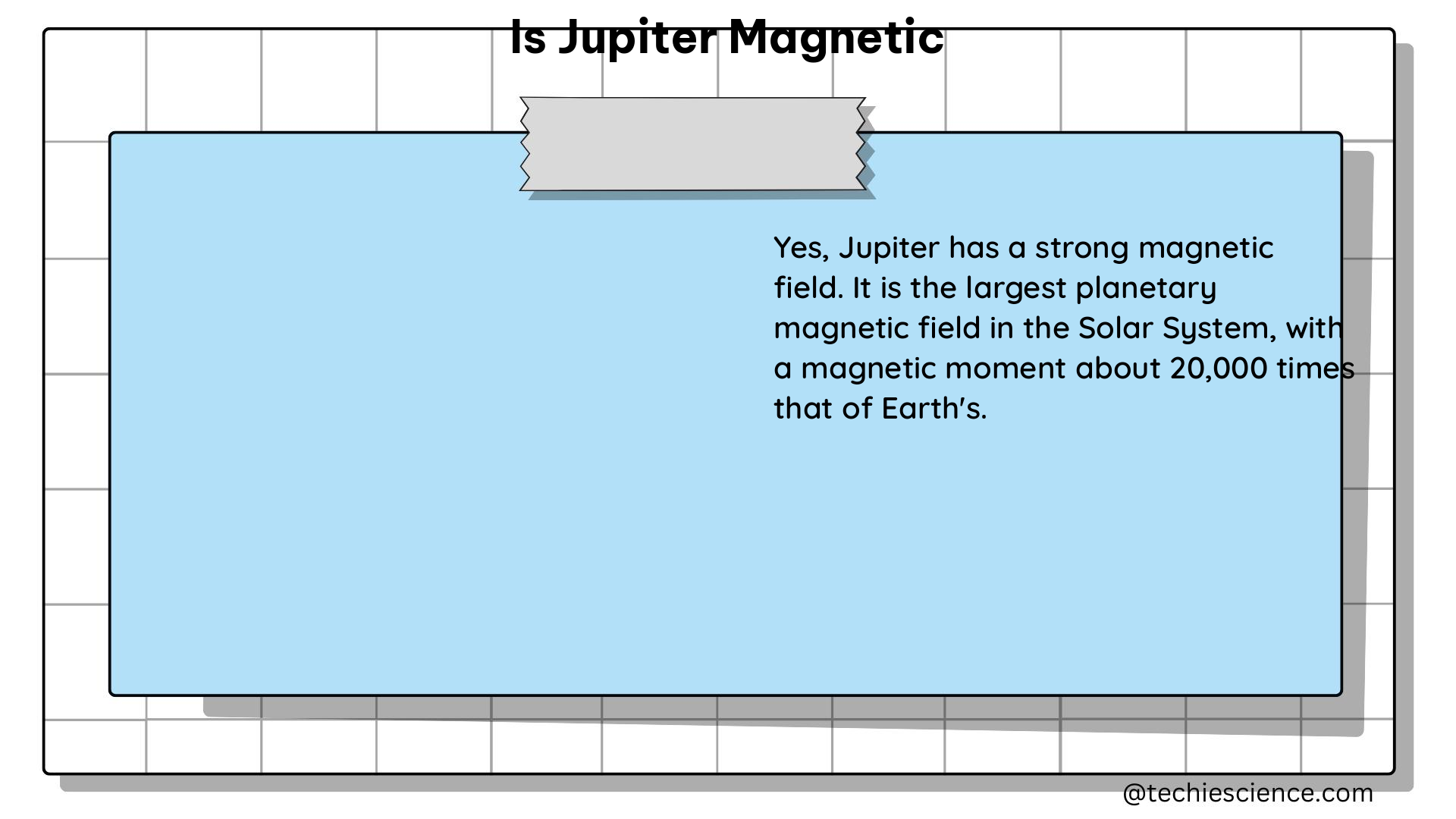Jupiter, the largest planet in our solar system, is known for its powerful and complex magnetic field, which sets it apart from Earth’s magnetic field. This blog post will delve into the intricate details of Jupiter’s magnetic field, providing a comprehensive understanding of its unique characteristics, measurable properties, and the underlying physics behind it.
Magnetic Moment and Equatorial Field Strength
Jupiter’s magnetic moment, a measure of the planet’s overall magnetic strength, is an astounding 2.83 × 10^20 T·m^3, which is approximately 20,000 times larger than Earth’s magnetic moment. This colossal magnetic moment translates to an equally impressive equatorial field strength of around 417.0 μT (4.170 G), about 20 times stronger than Earth’s equatorial field strength of 30-60 μT.
The magnetic field strength (B) of a planet can be calculated using the formula:
B = μ₀ * M / r^3
where μ₀ is the permeability of free space (4π × 10^-7 T·m/A), M is the magnetic moment of the planet, and r is the distance from the center of the planet.
Dipole Tilt and Magnetic Field Lines

Jupiter’s magnetic field is tilted roughly 10° from its axis of rotation, similar to Earth’s magnetic field tilt of 11.3°. This tilt is a result of the complex interplay between the planet’s internal dynamo and its rapidly rotating atmosphere.
The magnetic field lines of Jupiter are primarily radial near the poles and circular near the equator, with a intricate structure that includes quadrupole and octupole components. This complex field geometry is a consequence of the dynamic processes occurring within Jupiter’s interior, where the planet’s rapid rotation and convective motions in the metallic hydrogen layer drive the generation of the magnetic field.
Magnetosphere and Radiation Belts
Jupiter’s magnetosphere is the largest and most powerful in the solar system, extending approximately 650 million kilometers (400 million miles) from the planet. This vast magnetosphere is a result of the planet’s immense magnetic moment and its interaction with the solar wind.
Within this magnetosphere, Jupiter’s magnetic field traps charged particles, forming the planet’s radiation belts. These radiation belts can contain charged particles with energies up to 100 MeV, posing a significant hazard to spacecraft and astronauts that venture into this region.
The magnetic moment (M) of a planet can be calculated using the formula:
M = B * r^3 / μ₀
where B is the magnetic field strength at a given distance (r) from the center of the planet.
Magnetic Field Rotation and Changes
Jupiter’s magnetic field rotates at the same speed as the region below its atmosphere, with a period of 9 hours, 55 minutes. This synchronization between the magnetic field and the planet’s interior is a testament to the complex dynamics at play within Jupiter’s interior.
Recent measurements from the Juno spacecraft have revealed small but measurable changes in Jupiter’s magnetic field, including the discovery of a region of strongly non-dipolar field near the equator, known as the “Great Blue Spot.” These changes highlight the dynamic nature of Jupiter’s magnetic field and the ongoing processes that shape its evolution.
Physics Examples and Numerical Problems
Jupiter’s powerful magnetic field can create a “magnetic tornado” that reaches from the planet’s surface to its upper atmosphere, a phenomenon that has been observed and studied by scientists.
Additionally, the interaction between Jupiter’s magnetic field and the solar wind can create a shock wave that can affect the planet’s magnetosphere and atmosphere, influencing the overall dynamics of the Jovian system.
To further illustrate the concepts discussed, here are two numerical problems:
- Calculate the magnetic field strength of Jupiter at a distance of 100,000 kilometers from its center, given its magnetic moment of 2.83 × 10^20 T·m^3.
- Calculate the magnetic moment of a planet with a magnetic field strength of 0.5 μT at a distance of 5,000 kilometers from its center.
Figures, Data Points, and Measurements
- Jupiter’s magnetic field strength at its equator is about 417.0 μT (4.170 G).
- Jupiter’s magnetic moment is about 2.83 × 10^20 T·m^3.
- Jupiter’s magnetic field is tilted roughly 10° from its axis of rotation.
- Jupiter’s magnetosphere extends about 650 million kilometers (400 million miles) from the planet.
- Jupiter’s radiation belts can contain charged particles with energies up to 100 MeV.
- Jupiter’s magnetic field rotates at the same speed as the region below its atmosphere, with a period of 9 hours, 55 minutes.
Conclusion
Jupiter’s magnetic field is a remarkable and complex phenomenon, with numerous unique characteristics that set it apart from Earth’s magnetic field. From its colossal magnetic moment and equatorial field strength to its dynamic magnetosphere and radiation belts, Jupiter’s magnetic field is a testament to the intricate processes occurring within the planet’s interior.
Understanding the intricacies of Jupiter’s magnetic field is crucial for studying the planet’s overall behavior, as well as for developing strategies to protect spacecraft and astronauts from the hazards posed by its powerful radiation belts. The insights gained from the study of Jupiter’s magnetic field can also contribute to our broader understanding of planetary magnetism and the underlying physics that govern these phenomena.
References
Hi, I’m Akshita Mapari. I have done M.Sc. in Physics. I have worked on projects like Numerical modeling of winds and waves during cyclone, Physics of toys and mechanized thrill machines in amusement park based on Classical Mechanics. I have pursued a course on Arduino and have accomplished some mini projects on Arduino UNO. I always like to explore new zones in the field of science. I personally believe that learning is more enthusiastic when learnt with creativity. Apart from this, I like to read, travel, strumming on guitar, identifying rocks and strata, photography and playing chess.